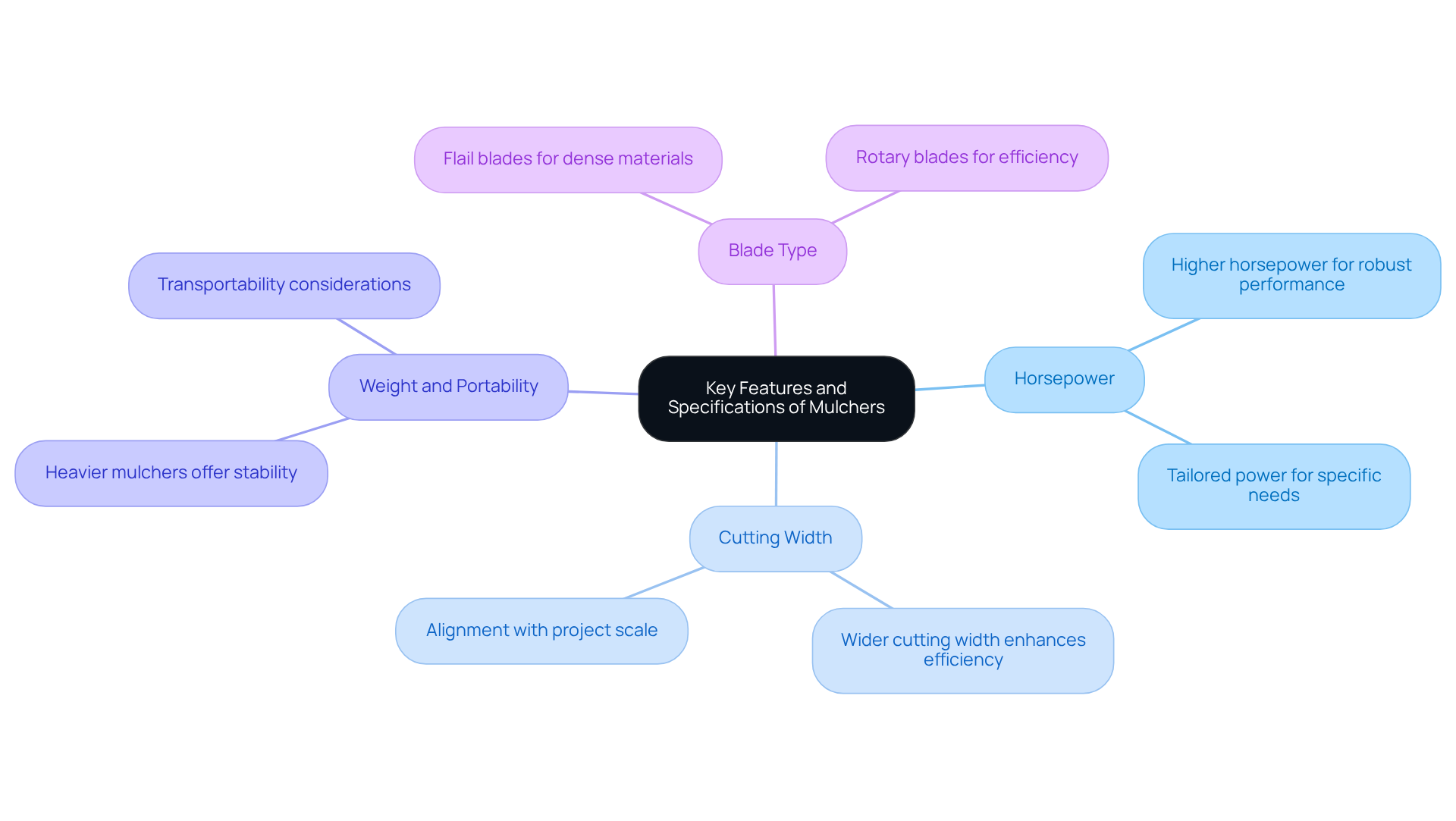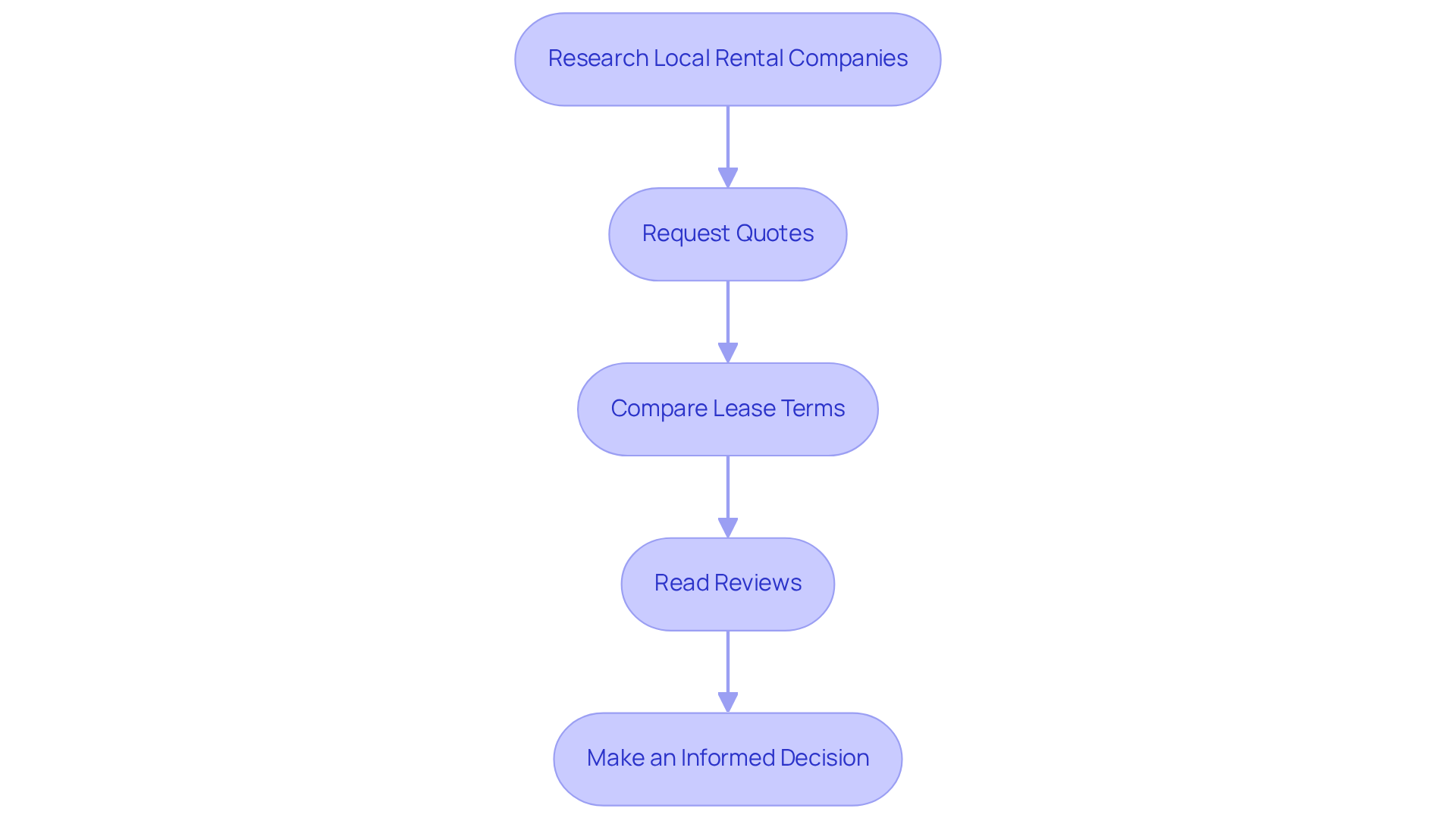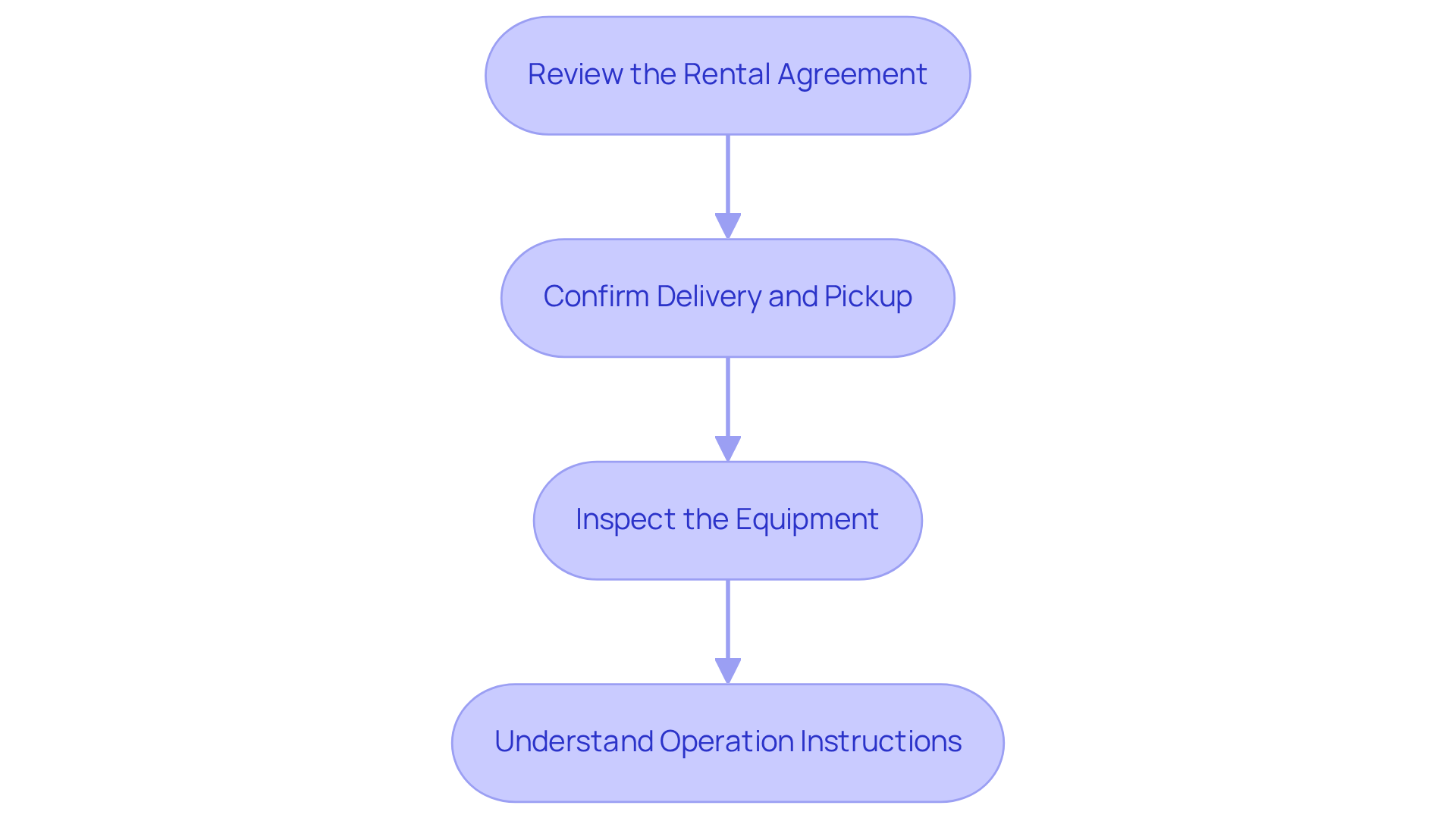Overview
Choosing the right rental mulcher for your project is crucial. Understanding the various types of mulchers available—tow-behind, walk-behind, and tractor-mounted—is the first step. Each type of mulcher is designed for specific tasks, and evaluating key features such as horsepower, cutting width, and blade type will help you make an informed decision. This article provides a comprehensive guide on comparing rental options and finalizing agreements, ensuring an effective and efficient project outcome.
In addition, the article elaborates on how each mulcher type excels in different scenarios. For instance, tow-behind mulchers are ideal for larger areas, while walk-behind models offer greater maneuverability for smaller, intricate spaces. By understanding these distinctions, you can select a mulcher that aligns with your project needs. Furthermore, the guide emphasizes the importance of reliability and quality in equipment rental, supported by testimonials from satisfied customers who have experienced the benefits firsthand.
To ensure you secure the best rental option, it is essential to evaluate not only the equipment but also the rental agreements available. This article outlines the steps necessary to finalize your rental, including tips for negotiating terms and understanding the fine print. By following this guide, you can confidently engage in the rental process and achieve your project goals with the right mulcher. Take action now to explore your rental options and ensure your project's success.
Key Highlights:
- Mulchers come in various types, including tow-behind, walk-behind, and tractor-mounted, each suited for specific tasks.
- Tow-behind mulchers are ideal for large areas and quick coverage, while walk-behind mulchers are better for detailed, smaller jobs.
- Tractor-mounted mulchers are powerful and suitable for agricultural and forestry applications.
- Key features to consider when selecting a mulcher include horsepower, cutting width, weight, and blade type.
- Research local rental companies and request quotes to compare prices and terms before renting a mulcher.
- Review the rental agreement thoroughly, confirm delivery and pickup logistics, and inspect the equipment upon arrival.
- Understand operation instructions and request demonstrations to ensure effective use of the rental mulcher.
Introduction
Selecting the appropriate rental mulcher can be a daunting task, given the diverse options tailored for specific applications. Grasping the various types of mulchers and their distinct uses is crucial for optimizing efficiency and achieving superior results in any undertaking.
With numerous factors to contemplate—from equipment specifications to rental agreements—how can one guarantee an informed decision? This guide delineates the essential steps to streamline the selection process, equipping readers with the confidence to choose the ideal mulcher for their requirements.
Understand Mulcher Types and Their Applications
Mulchers are available in several types, each tailored for specific applications. Understanding these options is crucial for selecting the right equipment, such as a rental mulcher, for your needs, ensuring both efficiency and effectiveness.
- Tow-Behind Mulchers are perfect for larger areas. These machines attach to a vehicle, enabling quick coverage of extensive ground. They excel in clearing brush and overgrown vegetation, making them a reliable choice for significant clearing tasks.
- Walk-Behind Mulchers are designed for smaller, more intricate jobs. Their maneuverability allows them to navigate tight spaces with ease. Frequently utilized in residential landscaping, they provide a practical solution for detailed work, ensuring a polished finish.
- Tractor-Mounted Mulchers represent the power of heavy-duty clearing. These robust machines attach directly to a tractor, making them ideal for agricultural or forestry applications. Their strength and efficiency make them indispensable for tackling demanding tasks.
By comprehending the use of each category, you can confidently select the appropriate rental mulcher for your task. This knowledge not only enhances your effectiveness but also ensures that you achieve the best results in your projects. Explore our range of mulchers today to find the perfect fit for your needs!

Evaluate Key Features and Specifications
When evaluating mulchers, it is essential to consider the following key features to ensure optimal performance for your specific tasks:
- Horsepower: A higher horsepower rating allows for more robust performance, particularly in challenging conditions. It is crucial to ensure the mulcher possesses sufficient power tailored to your specific needs.
- Cutting Width: Opting for a wider cutting width can significantly enhance efficiency by covering more ground in a shorter amount of time. However, it is important to confirm that the width aligns with the scale of your undertaking.
- Weight and Portability: While heavier mulchers may offer greater stability, they can also pose challenges in terms of transportability. Assess your transportation capabilities and the accessibility of your site before making a decision.
- Blade Type: The type of blade—whether flail or rotary—can greatly influence the machine's efficiency across various materials. It is advisable to select a blade type that best fits your requirements.
By thoroughly evaluating these characteristics, you can confidently choose a device that will operate effectively for your project.

Compare Rental Options and Pricing
To identify the best rental option for your mulcher, adhere to the following steps:
- Research Local Rental Companies: Begin by pinpointing reputable equipment rental companies in your vicinity. EZ Equipment Rental stands out with its extensive selection of mulchers, guaranteeing access to high-quality equipment. Their unwavering commitment to excellence and customer satisfaction positions them as a premier choice in the DFW area.
- Request Quotes: Reach out to multiple leasing firms to gather quotes. It is essential to inquire about any additional fees, such as delivery charges or insurance costs, which can significantly impact your overall budget.
- Compare Lease Terms: Evaluate the lease terms, focusing on duration, maintenance policies, and any included services. Companies like EZ Equipment Rental provide flexible leasing durations, potentially leading to substantial savings. This adaptability is vital for effectively managing project costs.
- Read Reviews: Delve into customer feedback and ratings to gauge the reliability and service quality of various leasing businesses. Statistics reveal that companies with superior service quality ratings tend to cultivate higher customer satisfaction, underscoring the importance of selecting a dependable provider. For instance, the equipment leasing industry is poised for considerable growth, further emphasizing the necessity of making an informed choice.
By meticulously comparing these factors, you can arrive at a decision that harmonizes quality and cost, ensuring your project progresses seamlessly.

Finalize Your Rental Agreement and Logistics
To finalize your rental of a mulcher, adhere to these essential steps:
- Review the Rental Agreement: It is crucial to thoroughly examine the rental agreement to understand all terms and conditions, particularly those related to liability and maintenance responsibilities. Comprehending these aspects is vital to prevent unforeseen fees or issues during your leasing period. As legal expert Daniel Kaplan emphasizes, "You should charge for delivery as a separate service; do not include it in the basic fee."
- Confirm Delivery and Pickup: Collaborate with the leasing service to establish specific delivery and pickup dates and times for the machine. This proactive approach helps prevent scheduling conflicts and ensures that the equipment is available when you need it. Be aware that delivery charges can vary based on distance, with rates starting at $80 for a round trip up to 5 miles.
- Inspect the Equipment: Upon delivery, conduct a thorough inspection of the rental mulcher for any signs of damage or operational issues. Promptly notify any discrepancies to the leasing firm to avoid being held responsible for pre-existing conditions. Furthermore, understand the leasing firm’s policies regarding repairs and replacements in the event of equipment malfunctions during your project.
- Understand Operation Instructions: Ensure you receive comprehensive instructions on the safe and effective operation of the rental mulcher. If necessary, request a demonstration from the leasing company to familiarize yourself with the equipment's features and functions. Recognizing the average delivery time for equipment can also assist you in managing your timeline effectively.
By following these steps, you can facilitate a smooth rental experience and be well-prepared to manage your project efficiently.

Conclusion
Selecting the right rental mulcher is a critical step in ensuring the success of your landscaping or clearing project. Understanding the various types of mulchers available—such as tow-behind, walk-behind, and tractor-mounted—equips individuals with the knowledge necessary to choose the most suitable equipment for their specific tasks. This informed decision-making not only enhances project efficiency but also contributes to achieving optimal results.
Key considerations when renting a mulcher include:
- Evaluating horsepower
- Cutting width
- Weight
- Blade type
Each of these features plays a significant role in the machine's performance and suitability for different projects. Furthermore, comparing rental options, pricing, and lease terms can lead to significant savings and a more streamlined experience. By carefully assessing local rental companies, gathering quotes, and reading customer reviews, one can ensure a reliable choice that meets both budgetary and project requirements.
Ultimately, taking the time to understand the intricacies of mulcher rentals can lead to a more effective project execution. Whether it's for a large-scale clearing task or a detailed landscaping job, the right equipment can make all the difference. Embrace the opportunity to research and select the best mulcher for your needs, and approach the rental process with diligence to ensure a successful and hassle-free experience.
Frequently Asked Questions
What are the different types of mulchers available?
The main types of mulchers are Tow-Behind Mulchers, Walk-Behind Mulchers, and Tractor-Mounted Mulchers.
What are Tow-Behind Mulchers used for?
Tow-Behind Mulchers are ideal for larger areas, as they attach to a vehicle and are effective in clearing brush and overgrown vegetation.
When should I use a Walk-Behind Mulcher?
Walk-Behind Mulchers are designed for smaller, more intricate jobs and are commonly used in residential landscaping due to their maneuverability in tight spaces.
What applications are Tractor-Mounted Mulchers suited for?
Tractor-Mounted Mulchers are heavy-duty machines that attach directly to a tractor, making them suitable for agricultural or forestry applications where strength and efficiency are required.
How can understanding mulcher types help in selecting the right equipment?
By understanding the specific applications of each mulcher type, you can confidently choose the appropriate rental mulcher for your task, enhancing effectiveness and achieving better results.




